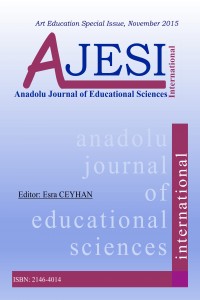Öz
Based on this viewpoint, the present study aims at teaching the concept of tissue to the autistic children. In the study, an education environment aided by visual materials was created by using the sense organs peculiar to these children and the effects of learning was put forward. Research group consisted of two autistic children who were aged 12. Research presented a case study. Qualitative data in the research were obtained by interview, observation and assessment of the students' paintings by the researchers. Interview was carried out by asking five questions to the mothers and visual arts teachers of the students. Paintings of the children were assessed and interpreted in line with the painting assessment criteria developed by the researchers. Data of the observation included the interpretation of the records taken during the practices via video tapes and photographs. According to the interview data obtained in the research, families and visual arts teachers are of the conviction that art activities have positive impacts on autistic children and art lessons are essential. At the end of the observation, it was concluded that teaching the concept of tissue to the autistic children through different techniques and materials was more effective and enabled them to participate in the course willingly. Paintings of students were acclaimed in terms of colour, setting, texture and technique. Results of the research showed once more that a purposeful art education should be included in the programs of special education institutions for the education of autistic children.
Anahtar Kelimeler
Kaynakça
- Ataman, A. (2003). Children in Need Special Care and Introduction to Special Education,
- -
- Ataman, A. (Editor). Children in Need Special Care and Special Education. First Edition. Ankara: Gündüz Eğitim ve Yayıncılık, pp.19.
- Artut, K. (2009). Art Education Hypothesis and Methods. (6th Edition). Ankara: Anı Press.
- Buyurgan, S. and Buyurgan, U. (2012). Art Education and Teaching. (3rd Edition). Ankara: Pegem A Press.
- Grandin, T. (2005). Thinking with pictures. (Translated by M.C.İftar). İstanbul: Doğan Press. (The original edition was issued under the name of “………..”).
- Kayaalp, İ.V. (2000). Education of Children with SOS Autism and Communication Problem. (1st Edition). İstanbul: Evrim Press.
- Kayaoğlu, N. and Görür, Ö. (2008). How do children with autism learn? (1st Edition). Ankara: Eros Press.
- Korkmaz, B. (2000). What is the Rainman Autism?. (1st Edition). İstanbul: Doğan Press.
- Kınalı, G. (2003). Children with unusual development. Kulaksızoğlu, A. (Editor). Physical Art-Music Education for Mentally Challenged Children. Second Edition. İstanbul: Epsilon Press. pp. 257-259.
- Kırışoğlu, O.T. (2009). Art Culture Creativity. (1st Edition). Ankara: Pegem A Press.
- Özbey, Ç. (2005). Autism and education of children with autism: a journey to the land of loneliness. (1st Edition). İstanbul: İnkılap Press.
- Sucuoğlu, B. (2003). Children Need Special Care and Introduction to Special Education., Ataman, A. (Editor). Autism and Children with Autism. First Edition. Anakara: Gündüz Eğitim ve Yayıncılık, pp.400.
- Turan, A. (2005). Children Who Speak Language of Love. (3rd Edition). İstanbul: Sistem Press.
- Wing, L. (2005). Hand Book of Autism. (Translated by. Semra Kunt). İstanbul: Doğan Press. (Original edition was issued in 1996).
- Yıldırım, A. and Şimşek, H. (2008). Qualitative Research Methods in Social Science. (6th Edition). Ankara: Seçkin Press.
Öz
Kaynakça
- Ataman, A. (2003). Children in Need Special Care and Introduction to Special Education,
- -
- Ataman, A. (Editor). Children in Need Special Care and Special Education. First Edition. Ankara: Gündüz Eğitim ve Yayıncılık, pp.19.
- Artut, K. (2009). Art Education Hypothesis and Methods. (6th Edition). Ankara: Anı Press.
- Buyurgan, S. and Buyurgan, U. (2012). Art Education and Teaching. (3rd Edition). Ankara: Pegem A Press.
- Grandin, T. (2005). Thinking with pictures. (Translated by M.C.İftar). İstanbul: Doğan Press. (The original edition was issued under the name of “………..”).
- Kayaalp, İ.V. (2000). Education of Children with SOS Autism and Communication Problem. (1st Edition). İstanbul: Evrim Press.
- Kayaoğlu, N. and Görür, Ö. (2008). How do children with autism learn? (1st Edition). Ankara: Eros Press.
- Korkmaz, B. (2000). What is the Rainman Autism?. (1st Edition). İstanbul: Doğan Press.
- Kınalı, G. (2003). Children with unusual development. Kulaksızoğlu, A. (Editor). Physical Art-Music Education for Mentally Challenged Children. Second Edition. İstanbul: Epsilon Press. pp. 257-259.
- Kırışoğlu, O.T. (2009). Art Culture Creativity. (1st Edition). Ankara: Pegem A Press.
- Özbey, Ç. (2005). Autism and education of children with autism: a journey to the land of loneliness. (1st Edition). İstanbul: İnkılap Press.
- Sucuoğlu, B. (2003). Children Need Special Care and Introduction to Special Education., Ataman, A. (Editor). Autism and Children with Autism. First Edition. Anakara: Gündüz Eğitim ve Yayıncılık, pp.400.
- Turan, A. (2005). Children Who Speak Language of Love. (3rd Edition). İstanbul: Sistem Press.
- Wing, L. (2005). Hand Book of Autism. (Translated by. Semra Kunt). İstanbul: Doğan Press. (Original edition was issued in 1996).
- Yıldırım, A. and Şimşek, H. (2008). Qualitative Research Methods in Social Science. (6th Edition). Ankara: Seçkin Press.
Ayrıntılar
| Birincil Dil | İngilizce |
|---|---|
| Bölüm | Araştırma Makalesi |
| Yazarlar | |
| Yayımlanma Tarihi | 15 Aralık 2015 |
| Gönderilme Tarihi | 15 Aralık 2015 |
| Yayımlandığı Sayı | Yıl 2015 Cilt: 5 Sayı: 3 |
Kaynak Göster

AJESI’de yayınlanan makalelerde bu lisans kullanılmaktadır.
Creative Commons Attribution-NonCommercial-ShareAlike 4.0 International License.

